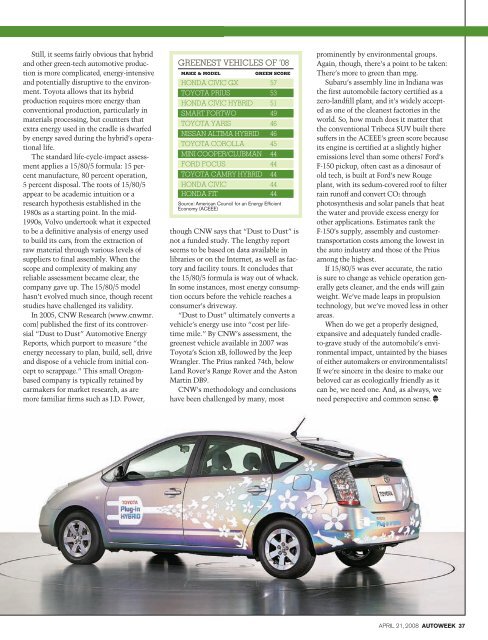SPECIAL EARTH DAY DOUBLE ISSUE - AutoWeek
SPECIAL EARTH DAY DOUBLE ISSUE - AutoWeek
SPECIAL EARTH DAY DOUBLE ISSUE - AutoWeek
Create successful ePaper yourself
Turn your PDF publications into a flip-book with our unique Google optimized e-Paper software.
Still, it seems fairly obvious that hybrid<br />
and other green-tech automotive production<br />
is more complicated, energy-intensive<br />
and potentially disruptive to the environment.<br />
Toyota allows that its hybrid<br />
production requires more energy than<br />
conventional production, particularly in<br />
materials processing, but counters that<br />
extra energy used in the cradle is dwarfed<br />
by energy saved during the hybrid’s operational<br />
life.<br />
The standard life-cycle-impact assessment<br />
applies a 15/80/5 formula: 15 percent<br />
manufacture, 80 percent operation,<br />
5 percent disposal. The roots of 15/80/5<br />
appear to be academic intuition or a<br />
research hypothesis established in the<br />
1980s as a starting point. In the mid-<br />
1990s, Volvo undertook what it expected<br />
to be a definitive analysis of energy used<br />
to build its cars, from the extraction of<br />
raw material through various levels of<br />
suppliers to final assembly. When the<br />
scope and complexity of making any<br />
reliable assessment became clear, the<br />
company gave up. The 15/80/5 model<br />
hasn’t evolved much since, though recent<br />
studies have challenged its validity.<br />
In 2005, CNW Research (www.cnwmr.<br />
com) published the first of its controversial<br />
“Dust to Dust” Automotive Energy<br />
Reports, which purport to measure “the<br />
energy necessary to plan, build, sell, drive<br />
and dispose of a vehicle from initial concept<br />
to scrappage.” This small Oregonbased<br />
company is typically retained by<br />
carmakers for market research, as are<br />
more familiar firms such as J.D. Power,<br />
GREENEST VEHICLES OF ‘08<br />
MAKE & MODEL GREEN SCORE<br />
HONDA CIVIC GX 57<br />
TOYOTA PRIUS 53<br />
HONDA CIVIC HYBRID 51<br />
SMART FORTWO 49<br />
TOYOTA YARIS 46<br />
NISSAN ALTIMA HYBRID 46<br />
TOYOTA COROLLA 45<br />
MINI COOPER/CLUBMAN 44<br />
FORD FOCUS 44<br />
TOYOTA CAMRY HYBRID 44<br />
HONDA CIVIC 44<br />
HONDA FIT 44<br />
Source: American Council for an Energy Efficient<br />
Economy (ACEEE)<br />
though CNW says that “Dust to Dust” is<br />
not a funded study. The lengthy report<br />
seems to be based on data available in<br />
libraries or on the Internet, as well as factory<br />
and facility tours. It concludes that<br />
the 15/80/5 formula is way out of whack.<br />
In some instances, most energy consumption<br />
occurs before the vehicle reaches a<br />
consumer’s driveway.<br />
“Dust to Dust” ultimately converts a<br />
vehicle’s energy use into “cost per lifetime<br />
mile.” By CNW’s assessment, the<br />
greenest vehicle available in 2007 was<br />
Toyota’s Scion xB, followed by the Jeep<br />
Wrangler. The Prius ranked 74th, below<br />
Land Rover’s Range Rover and the Aston<br />
Martin DB9.<br />
CNW’s methodology and conclusions<br />
have been challenged by many, most<br />
prominently by environmental groups.<br />
Again, though, there’s a point to be taken:<br />
There’s more to green than mpg.<br />
Subaru’s assembly line in Indiana was<br />
the first automobile factory certified as a<br />
zero-landfill plant, and it’s widely accepted<br />
as one of the cleanest factories in the<br />
world. So, how much does it matter that<br />
the conventional Tribeca SUV built there<br />
suffers in the ACEEE’s green score because<br />
its engine is certified at a slightly higher<br />
emissions level than some others? Ford’s<br />
F-150 pickup, often cast as a dinosaur of<br />
old tech, is built at Ford’s new Rouge<br />
plant, with its sedum-covered roof to filter<br />
rain runoff and convert CO2 through<br />
photosynthesis and solar panels that heat<br />
the water and provide excess energy for<br />
other applications. Estimates rank the<br />
F-150’s supply, assembly and customertransportation<br />
costs among the lowest in<br />
the auto industry and those of the Prius<br />
among the highest.<br />
If 15/80/5 was ever accurate, the ratio<br />
is sure to change as vehicle operation generally<br />
gets cleaner, and the ends will gain<br />
weight. We’ve made leaps in propulsion<br />
technology, but we’ve moved less in other<br />
areas.<br />
When do we get a properly designed,<br />
expansive and adequately funded cradleto-grave<br />
study of the automobile’s environmental<br />
impact, untainted by the biases<br />
of either automakers or environmentalists?<br />
If we’re sincere in the desire to make our<br />
beloved car as ecologically friendly as it<br />
can be, we need one. And, as always, we<br />
need perspective and common sense. c<br />
APRIL 21, 2008 AUTOWEEK 37



